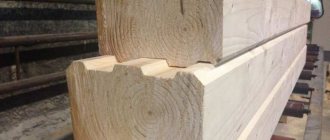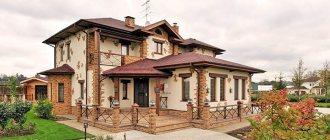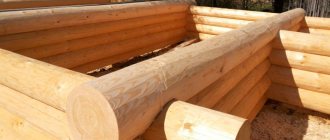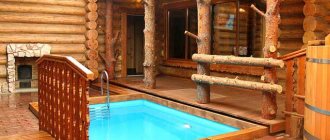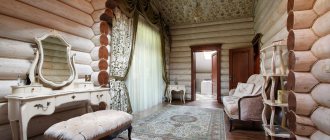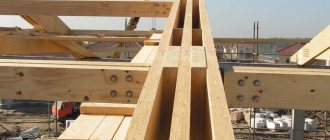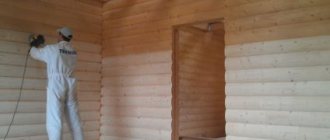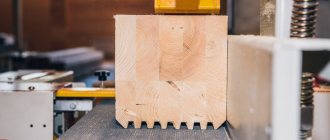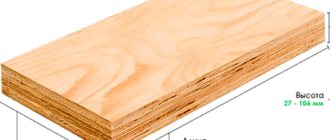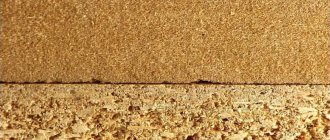There are several varieties of wooden lumber, so the consumer is faced with another question - which material to choose for construction: logs or timber.
Before buying this or that material, it is necessary to study the characteristics, nuances, advantages and disadvantages of both types.
Regular timber
A house made of ordinary timber is a convenient and rational construction, since there is no need to adjust wooden elements, there are great opportunities for working with interior decoration, and this is greatly appreciated by those who love an individual approach to design solutions.
You can now buy timber for building a house from any construction company, because it is the simplest material of all existing types of timber. It is worth noting that this is also the most environmentally friendly material, since people put the least amount of effort into it. True, the appearance of unplaned ordinary timber is very modest and not as presentable as that of profiled or glued timber, and it also requires finishing work and sometimes independent preparation for subsequent work. But there is also a positive point - the price of ordinary timber is much lower than for other types of this building material.
Advantages of ordinary timber
- Price. Due to the fact that the production process of this material is very simple, its price is very low compared to other types of wood.
- Easily accessible material - available at all construction companies.
- Easy to build walls.
Disadvantages of conventional timber
- Cracks often appear after shrinkage.
- The outside requires additional improvement - for example, cladding with a different material.
- Very often, the timber begins to deform, after which gaps appear and the walls of the building become warped.
- If you do not treat the timber with an antiseptic, the wood may turn blue.
Minuses
- If it is decided to finish the building, finishing work can only begin after the material has reached a certain level of relative humidity.
- During drying, unpleasant cracks may appear (especially if the construction was carried out at high outdoor temperatures).
- If profiled square beams were used during the construction of the building, cracks are likely to appear on all four sides.
Profiled timber
When building houses today, profiled timber is often used - this is a high-tech natural building material that is very convenient in construction.
This type of timber is usually made from coniferous trees. The manufacturing technology is as follows: first they plan, and then the milling process occurs. During all these manipulations, the timber is given its own shape - and it can be very diverse.
As a rule, the outer side of a profiled beam has a convex surface, and the inner side, which faces the house, has a flat surface. But some manufacturers make the timber flat on all sides, or convex on both sides.
The top and bottom of the profiled timber have notches in the form of a groove and a tenon - they are mirrored.
Profiled timber is a very good solution for various residential premises. This material makes very beautiful cottages and country houses, which do not require any additional work on the exterior, thanks to the perfectly smooth surface of the material. Your building will definitely look neat and cute after the timber has dried in natural conditions.
Advantages of profiled timber.
- Profiled timber is a 100% natural building material that does not contain synthetic or chemical components.
- Profiled timber is solid wood, qualitatively processed on the outside.
- Houses made of profiled timber are able to “breathe”, since these materials do not affect or disturb their natural structure.
- Thanks to the natural structure of the profiled timber, optimal humidity will always be maintained in the house and air exchange will be easy.
- Profiled timber gives the house a finished look - there is no need for the owner to think about finishing - this is completely unnecessary, since the external appearance of such a structure is excellent - it is neat and very attractive.
- The profiled timber fits perfectly against each other - this provides excellent thermal insulation.
- A house made of timber is not blown by the wind.
- Profiled timber protects the house from the occurrence of spots of rot, since, thanks to strong adhesion, water from rain and after snow melts does not get into the grooves.
- Houses made of profiled timber are more expensive than those made of regular timber, but cheaper than those made of laminated veneer lumber. It is believed that profiled timber costs two times less than laminated timber.
- Houses built from profiled timber are very warm.
- To facilitate the installation of the building, corner elements can be ordered in advance at the factory.
- Profiled timber gives the most minimal shrinkage, unlike regular and laminated timber. Cedar and pine shrink about 3.5%, and larch about 4.5%.
- A building made of profiled timber does not require caulking at the junction of the beams, which is mandatory when building a house from logs.
- Profiled timber does not need additional insulation - it will be enough to lay jute in the grooves.
- Profiled timber is considered the most rational solution when building a house, since it perfectly combines price and quality, and is also not difficult to build from.
Disadvantages of profiled timber.
- The house can be finished only after the profiled timber has reached the required relative humidity.
- When the profiled timber dries, cracks may appear in it, which depend on what time of year the structure was erected. If the house was built at a low temperature, then there will be few cracks, and they will be small, but if the house was built at a hot temperature, then there will be more cracks and they can be of impressive size.
- The total number of cracks after the profiled timber has dried can be influenced by its cross section. Due to the fact that due to internal stresses arising from different degrees of shrinkage, cracks will appear where the cross-section has a large area.
- Profiled square beams form cracks on all sides.
- To control cracks on profiled timber, it is necessary to make cuts - they will later define the crack line.
What is better to choose
The choice depends on the preferences of the owner.
The material is chosen taking into account many factors. The opinion of the developer is decisive , since only he can say what style of building he needs on the site.
In addition, circumstances are taken into account :
- the material side of the issue, taking into account not only the construction, but also additional caulking and cladding;
- required construction speed;
- type of building (housing for permanent residence, temporary summer house, gazebo, outbuildings).
The type of construction determines the thickness of the walls and the heat-insulating properties of the material; it may be necessary to install an additional insulating layer. The waiting time for final finishing also plays a role , which depends on the degree and period of shrinkage.
Glued laminated timber
Glued laminated timber, as the name suggests, is boards glued together. The manufacturing technology of this building material is very expensive - both in time and in money, so laminated veneer lumber is much more expensive than profiled timber.
The technology for gluing timber is as follows:
- The logs are sawn into boards (their sizes are different, depending on what final goals are being pursued, that is, what shape and size the beam will have).
- Boards - they are also called lamellas - are dried. This occurs in special chambers where the material can reach a residual moisture level of 10 to 12%.
- After the chambers, the boards on top are treated with antiseptics.
- After processing, the lamellas are laid on top of each other and connected using a microspike.
- The resulting blanks are sharpened and then glued together into finished beams.
The lamellas in the finished building material – laminated veneer lumber – can be positioned both vertically and horizontally. The number of boards can be from two to five, so the maximum thickness of the finished profiled timber is 250 mm. As a result, a fully finished laminated veneer lumber has a natural profile or the one obtained as a result of milling the beam.
Currently, laminated veneer lumber has several varieties according to its purpose: wall, window, load-bearing.
Advantages of laminated veneer lumber.
- A house made of laminated veneer lumber is very beautiful - it does not require any finishing, since this building material has a high quality front side. The boards used for this are high-quality wood from which defects and knots have been removed. At the same time, all boards for laminated veneer lumber are selected according to color, texture, structure, which allows the finished timber to have an ideal appearance.
- In operation, laminated veneer lumber does not lose its shape and does not change its size, because dried boards are used to make this material, which means that the finished laminated veneer lumber will not have internal stress, which is typical for solid wood.
- Glued laminated timber is known for the fact that it does not shrink, it does not crack, curl or bend.
- Glued laminated timber is a very dense and durable building material. It exceeds the performance of solid wood according to these criteria by about 50, or even 70%.
- When making laminated veneer lumber, specialists set the opposite direction for the wood fibers in the boards, thanks to which deformation of the timber is eliminated; even if the humidity changes, this type of timber will still “not move”.
- A house made of laminated veneer lumber is built very quickly, since installation does not take much time. All this is due to the fact that the parts are manufactured at the factory and fit together perfectly. On average, the installation of a house made of laminated veneer lumber takes just over a month.
- A house made of laminated veneer lumber can be built at any time of the year, since the shrinkage of this material is no more than 1%. That is, it can be improved immediately after construction.
- Glued laminated timber is not susceptible to pests and pathogenic microflora.
- Glued laminated timber is considered more durable and fire resistant.
Disadvantages of laminated veneer lumber.
- The high cost of the material due to the complexity of manufacturing laminated veneer lumber. On average, the price is three times higher than the cost of solid timber.
- Glued laminated timber is no longer considered an absolutely environmentally friendly building material, despite the fact that its manufacturers claim the opposite, saying that the adhesive composition that holds the boards together is absolutely natural and does not interfere with the “breathing” of the laminated timber.
Solid log
Our distant ancestors built houses from solid logs - just remember the log houses, many of which have survived to this day. Moreover, builders in those distant times could build a house without a single nail, using only one ax. And although since those times there are practically no craftsmen left, today the popularity of wooden house construction is again gaining momentum.
Advantages of a solid log
- A protective layer on logs that is rich in tree resins.
- If the log is processed manually, as in the photo, it will crack much less.
- A house made of solid logs is considered one of the most reliable buildings.
Disadvantages of solid logs
- The cost of construction is very expensive, since the log itself is known for the fact that its price is sometimes exorbitant.
- Construction is not progressing quickly; additional time is needed for work.
- For the house to shrink, you need to wait about two years.
- Shrinkage can sometimes reach 12%.
Definition
Beam is lumber obtained by cutting the sides of a log so that the cross-section is formed into a square or rectangle.
timber
A log is a section of a tree trunk with the knots removed.
Log
Rounded log
Rounded logs (OCB) are logs that are processed on special equipment until they reach the same diameter along the entire length and the desired profile is given to the log. After all these manipulations on factory equipment, the log trunk acquires an aesthetic appearance, however, the logs lose their protective layer, thanks to which the tree lasts longer and the building lasts a very long time. But here, too, modern compounds come to the aid of logs, which help the wood compensate for the lack of a protective layer.
Advantages of rounded logs
- Construction of a house from a log takes little time, unlike log houses.
- Rounded logs are cheaper.
- Houses made from rounded logs are very beautiful.
- Houses made of rounded logs maintain low thermal conductivity, natural air exchange and healthy energy.
- Thanks to the precise processing of logs, they fit neatly to each other - this improves thermal insulation.
- Walls made of rounded logs are not blown through even by strong winter winds.
Disadvantages of rounded logs
- A house made of rounded logs also takes a long time to shrink.
- After shrinkage, additional caulking is required.
- Logs have little protection from various weather factors.
- Logs can crack - sometimes there are a lot of them, and if moisture gets in, the tree will begin to rot.
- A house made of rounded logs is the most fire-hazardous building option, so heating and electricity systems need to be given close attention.
Before building a wooden house, you need to choose a building material. When choosing, you should make balanced arguments and under no circumstances rely on “maybe”. Remember, no matter what building material you choose - timber or logs, the most important thing is that your house will be built from natural material. It will be an environmentally friendly and harmonious home that will delight not only you, but also your children and even grandchildren.
Both timber and logs have positive and negative components, therefore, only you can decide which material to give preference to.
You can buy all the necessary materials and tools for working using the warm seam technology in our store:
Summing up
Before building a wooden house, you need to choose a building material. When choosing, you should not rely on chance; it is better to weigh all the pros and cons in advance. Remember, no matter what building material you choose - one beam or logs, remember, the most important thing is that your house will be built from natural material. It will be an environmentally friendly and harmonious home that will delight not only you, but also your children and even grandchildren.
Both timber and logs have positive and negative components, therefore, only you can decide which material to give preference to.
